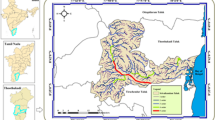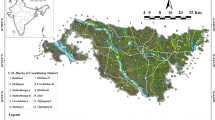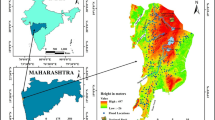Abstract
The Indo-Ganga–Brahmaputra plain is one of the world’s most vulnerable areas to catastrophic flood events. The severity and frequency of floods in this region have grown dramatically during the last few decades. As a result, an authentic map providing detailed spatial information on floods is required for reducing future flood disasters. This sort of map can be an invaluable tool for displaying flood-prone areas and determining the magnitude of flood risk. The Ramganga river (~ 200 km length) flowing in the western Gangetic plain was chosen for this investigation. This river is well known for its channel movement and flood hazards. The analytical hierarchy process model in GIS ambiance was used in this work to quantify and map flood risk in the lower Ramganga river basin. Six hazard-forming factors, namely relief, distance from active channel, slope, geomorphology, rainfall, and vegetation, and seven vulnerability factors, namely population density, household density, female density, road density, land use/land cover, female literacy, and total literacy, were chosen to determine flood risk zone (FRZ). According to the findings, about 35.29 per cent of the basin’s total area is in a high to very high flood risk zone, where flooding occurs at one- to three-year recurring intervals. The flood risk map has been validated using ground truth data, and the Kappa index has been computed, indicating a high degree of accuracy for the FRZ thematic classes.









Similar content being viewed by others
References
Abdullha, L., Jaafar, S., & Tai, I. (2013). Ranking of human capital indicators using analytic hierarchy process. Procedia - Social and Behavioural Sciences, 107, 22–28.
Ali, S. A., Khatun, R., Ahmad, A., & Ahmad, S. N. (2019). Application of GIS-based analytic hierarchy process and frequency ratio model to flood vulnerable mapping and risk area estimation at Sundarban region, India. Model Earth System Environment, 5, 1083–1102. https://doi.org/10.1007/s40808-019-00593-z
Aydin, M. C., & Sevgi Birincioğlu, E. (2022). Flood risk analysis using gis-based analytical hierarchy process: A case study of Bitlis Province. Applied Water Science, 12(6), 1–10.
Balica, S. F., Douben, N., & Wright, N. G. (2009). Flood vulnerability indices at varying spatial scales. Water Science and Technology, 60(10), 2571–2580.
Carmone, F. J., Kara, A., & Zanakis, S. H. (1997). A Monte Carlo investigation of incomplete pairwise comparison matrices in AHP. European Journal of Operational Research, 102, 538–553.
Census of India. (2011). Primary census abstract. Govt. of India.
Chakraborty, S., & Mukhopadhyay, S. (2019). Assessing food risk using analytical hierarchy process (AHP) and geographical information system (GIS): Application in Coochbehar district of West Bengal, India. Natural Hazards, 99, 247–274.
Chen, Y. R., Yeh, C. H., & Yu, B. (2011). Integrated application of the analytic hierarchy process and the geographic information system for flood risk assessment and flood plain management in Taiwan. Natural Hazards, 59, 1261–1276.
Dandapat, K., & Panda, G. K. (2017). Flood vulnerability analysis and risk assessment using analytical hierarchy process. Modeling Earth Systems and Environment, 3(4), 1627–1646. https://doi.org/10.1007/s40808-017-0388-7
Dang, N. M., Babel, M. S., & Luong, H. T. (2011). Evaluation of flood risk parameters in the day river flood diversion area, Red River Delta, Vietnam. Natural Hazards, 56, 169–194.
Danumah, J. H., Odai, S. N., Saley, B. M., Szarzynski, J., Thiel, M., Kwaku, A., Kouame, F. K., & Akpa, L. Y. (2016). Flood risk assessment and mapping in Abidjan District using multi-criteria analysis (AHP) model and geoinformation techniques (Cote d’ivoire). Geoenvironmental Disasters, 3(1), 10.
Das, S. (2020). Flood susceptibility mapping of the Western Ghat coastal belt using multi-source geospatial data and analytical hierarchy process (AHP). Remote Sensing Applications: Society and Environment, 20(November), 100379.
Dhar, O. N., & Nandargi, S. (1998). Floods in the Indian rivers and their meteorological aspects. In V. S. Kale (Ed.), Flood studies in India, Memoir 41 (pp. 1–25). Geological Survey of India.
Directive, E. U. (2007). 60/EC of the European parliament and of the council of 23 October 2007 on the assessment and management of flood risks. European Commission.
Emmanouloudis, D., Myronidis, D., & Ioannou, K. (2008). Assessment of flood risk in Thasos Island with the combined use of multicriteria analysis AHP and geographical information system. Innov Appl Info Agric Environ, 2, 103–115.
Fernandez, D. S., & Lutz, M. A. (2010). Urban flood hazard zoning in Tucumán Province, Argentina, using GIS and multicriteria decision analysis. Engineering Geology, 111, 90–98.
Ghosh, A., & Kar, S. K. (2018). Application of analytical hierarchy process (AHP) for food risk assessment: A case study in Malda district of West Bengal, India. Natural Hazards, 94, 349–368. https://doi.org/10.1007/s11069-018-3392-y
Hirabayashi, Y., Mahendran, R., Koirala, S., Konoshima, L., Yamazaki, D., Watanabe, S., Kim, H., & Kanae, S. (2013). Global flood risk under climate change. Nature Climate Change, 3, 816–821. https://doi.org/10.1038/nclimate1911
IPCC. (2007). Climate change 2007: Synthesis report Contribution of working groups I. II and III to the fourth assessment report of the intergovernmental panel on climate change (p. 104). IPCC.
IPCC. (2012). Managing the risks of extreme events and disasters to advance climate change adaptation. Cambridge Univ Press.
Kale, V. S. (1998). Monsoon floods in India: A hydro-geomorphic perspective. In V. S. Kale (Ed.), Flood studies in India, Memoir 41 (pp. 195–218). Geological Survey of India.
Kale, V. S. (2008). Himalayan catastrophe that engulfed North Bihar. Journal Geological Society of India, 72, 713–719.
Kale, V. S. (2012). On the link between extreme floods and excess monsoon epochs in South Asia. Climate Dynamics, 39, 1107–1122. https://doi.org/10.1007/s00382-011-1251-6
Kamp, U., Owen, L. A., Growley, B. J., & Khattak, G. A. (2010). Back analysis of landslide susceptibility zonation mapping for the 2005 Kashmir earthquake: An assessment of the reliability of susceptibility zoning maps. Natural Hazards, 54, 1–25.
Kasperson, J. X., Kasperson, R. E., & Turner, B. L. (2009). Vulnerability of coupled human-ecological systems to global environmental change. In A. Dieckmann, T. Dietz, & C. C. Jaeger (Eds.), Human footprints on the global environment (pp. 231–294). MIT Press.
Kazakis, N., Kougias, I., & Patsialis, T. (2015). Assessment of flood hazard areas at a regional scale using an index-based approach and Analytical Hierarchy Process: Application in Rhodope-Evros region, Greece. Science of the Total Environment, 538, 555–563. https://doi.org/10.1016/j.scitotenv.2015.08.055
Khan, A. U., Rawat, B. P. (1992). Quaternary geology and geomorphology of a part of Ganga basin in parts of Bareilly, Badaun, Shahjahanpur and Pilibhit district, Uttar Pradesh. G.S.I.
Khan, M. Y. A., Daityari, S., & Chakrapani, G. J. (2016). Factors responsible for temporal and spatial variations in water and sediment discharge in Ramganga River, Ganga Basin, India. Environmental Earth Science, 75, 283.
Liu, J. G., & Mason, P. J. (2009). Essential image processing and GIS for remote sensing. Wiley.
Luu, C., Meding, J. V., & Kanjanabootra, S. (2018). Assessing flood hazard using flood marks and analytic hierarchy process approach: A case study for the 2013 flood event in Quang Nam, Vietnam. Natural Hazards, 90, 1031–1050. https://doi.org/10.1007/s11069-017-3083-0
Meyer, V., Scheuer, S., & Haase, D. (2008). A multicriteria approach for flood risk mapping exemplified at the Mulde river, Germany. Natural Hazards, 48, 17–39. https://doi.org/10.1007/s11069-008-9244-4
Mishra, K., & Sinha, R. (2020). Flood risk assessment in the Kosi megafan using multi-criteria decision analysis: A hydro-geomorphic approach. Geomorphology, 350, 106861.
Mukherjee, R. (2022). Quantitative assessment of channel planform dynamics and meander bend evolution of the Ramganga River, Ganga Basin, India. In P. K. Shit, B. Bera, A. Islam, S. Ghosh, & G. S. Bhunia (Eds.), Drainage basin dynamics (pp. 89–113). Springer.
Mukherjee, R., & Bilas, R. (2019). Flood frequency analysis of Ramganga River Basin in Western Gangetic Plain, India. National Geographical Journal of India, 35(3), 286–299.
Mukherjee, R., Bilas, R., Biswas, S. S., & Pal, R. (2017). Bank erosion and accretion dynamics explored by GIS techniques in lower Ramganga river, Uttar Pradesh, India. Spatial Information Research. https://doi.org/10.1007/s41324-016-0074-2
Mukolwe, M. M. (2016). Flood hazard mapping: Uncertainty and its value in the decision-making process (p. 134). CRC Press/Balkema.
Ogatoa, G. S., Bantiderb, A., Abebec, K., & Genelettid, D. (2020). Geographic information system (GIS)-Based multicriteria analysis of flooding hazard and risk in Ambo Town and its watershed, West shoa zone, oromia regional State. Ethiopia Journal of Hydrology: Regional Studies, 27, 100659.
Ouma, Y. O., & Tateishi, R. (2014). Urban flood vulnerability and risk mapping using integrated multi-parametric AHP and GIS: Methodological overview and case study assessment. Water, 6, 1515–1545.
Papaioannou, G., Vasiliades, L., & Loukas, A. (2014). Multi-criteria analysis framework for potential flood prone areas mapping. Water Resour Manag, 29, 399–418. https://doi.org/10.1007/s11269-014-0817-6
Pathan, A. I., Girish Agnihotri, P., Said, S., & Patel, D. (2022). AHP and TOPSIS based flood risk assessment- a case study of the Navsari City, Gujarat, India. Environmental Monitoring and Assessment, 194, 509.
Penki, R., Basina, S. S., Tanniru, S. R. (2022). Application of geographical information system-based analytical hierarchy process modeling for flood susceptibility mapping of Krishna District in Andhra Pradesh.https://doi.org/10.21203/rs.3.rs-1399020/v1.PPR:PPR470200
Radwan, F., Alazba, A. A., & Mossad, A. (2018). Flood risk assessment and mapping using AHP in arid and semiarid regions. Acta Geophysica, 67, 215–229. https://doi.org/10.1007/s11600-018-0233-z
Rahmati, O., Zeinivand, H., & Besharat, M. (2016). Flood hazard zoning in Yasooj region, Iran, using GIS and multi-criteria decision analysis. Geomatics, Natural Hazards and Risk, 7(3), 1000–1017.
Rao, D. P., Bhanumurty, V., Rao, G. S., & Manjusri, P. (1998). Remote sensing and GIS in flood management in India. In V. S. Kale (Ed.), Flood studies in India, Memoir 41 (pp. 195–218). Geological Survey of India.
Rimba, A. B., Setiawati, M. D., Sambah, A. B., & Miura, F. (2017). Physical flood vulnerability mapping applying geospatial techniques in Okazaki City, Aichi Prefecture, Japan. Urban Science, 1(7), 1–22.
Roy, N. (2009). Morphodynamics and late quaternary valley-interfluve statigraphy of the western Ganga Plains: Rhythmic sequences and monsoon forcing. Unpublished PhD thesis, Dept. of Civil Engineering, IIT Kanpur.
Roy, N., & Sinha, R. (2007). Understanding confluence dynamics in the alluvial Ganga– Ramganga valley, India: An integrated approach using geomorphology and hydrology. Geomorphology, 92, 182–197.
Saaty, T. (1977). A scaling method for priorities in hierarchical structures. Journal of Mathematical Psychology, 15, 234–281.
Saaty, T. L. (1980). The analytic hierarchy process. McGraw-Hill.
Saaty, T. L. (1990). How to make a decision: The analytic hierarchy process. European Journal of Operational Research, 48(1), 9–26.
Saaty, T. L. (2008). Decision making with the analytic hierarchy process. International Journal of Services Sciences, 1, 83–98.
Sanyal, J., & Lu, X. X. (2006). Remote sensing and GIS-based flood vulnerability assessment of human settlements: A case study of Gangetic West Bengal, India. Hydrological Processes, 19, 3699–3716. https://doi.org/10.1002/hyp.5852
Sar, N., Chatterjee, S., & Adhikari, M. D. (2015). Integrated remote sensing and GIS based spatial modelling through analytical hierarchy process (AHP) for water logging hazard, vulnerability and risk assessment in Keleghai river basin, India. Modeling Earth Systems and Environment, 1, 31. https://doi.org/10.1007/s40808-015-0039-9
Seejata, K., Yodying, A., Wongthadam, T., Mahavik, N., & Tantanee, S. (2018). Assessment of flood hazard areas using analytical hierarchy process over the lower Yom Basin, Sukhothai Province. Procedia Engineering, 212, 340–347.
Sharma, S., & Mahajan, A. K. (2019). A comparative assessment of information value, frequency ratio and analytical hierarchy process models for landslide susceptibility mapping of a Himalayan watershed, India. Bulletin of Engineering Geology and the Environment, 78(4), 2431–2448.
Sharma, S. V. S., Roy, P. S., Chakravarthi, V., & Srinivasa Rao, G. (2018). Flood risk assessment using multi-criteria analysis: A case study from Kopili river basin, Assam, India. Geomatics, Natural Hazards and Risk, 9(1), 79–93. https://doi.org/10.1080/19475705.2017.1408705
Sinha, R. (2009). The Great avulsion of Kosi on 18 August 2008. Current Science, 97(3), 429–433.
Sinha, R., Bapalu, G. V., Singh, L. K., & Rath, B. (2008). Flood risk analysis in the Kosi river basin, using multiparametric approach of analytical hierarchy process (AHP). Journal of the Indian Society of Remote Sensing, 36, 335–349.
Souissi, D., Zouhri, L., Hammami, S., Msaddek, M. H., Zghibi, A., & Dlala, M. (2020). GIS-based MCDM–AHP modeling for flood susceptibility mapping of arid areas, southeastern Tunisia. Geocarto International, 35(9), 991–1017.
Stefanidis, S., & Stathis, D. (2013). Assessment of flood hazard based on natural and anthropogenic factors using analytic hierarchy process (AHP). Natural Hazards, 68, 569–585.
Tang, Z., Zhang, H., Yi, S., & Xiao, Y. (2018). Assessment of flood susceptible areas using spatially explicit, probabilistic multi-criteria decision analysis. Journal of Hydrology, 558, 144–158. https://doi.org/10.1016/j.jhydrol.2018.01.033
Tiwari, R. C. (2007). Geography of India (p. 840). Prayag Pustak Bhawan.
UNISDR. (2009). Terminology on disaster risk reduction. Geneva, Switzerland. Retrieved February 26, 2021, from http://ww.unisdr.org/files/7817_UNISDRTerminilogyEnglish.pdf
United Nations, Department of Humanitarian Affairs. (1992). Internationally agreed glossary of basic terms related to disaster management (DNA/93/36). United Nations.
Wang, Q., & Li, W. (2017). A GIS-based comparative evaluation of analytical hierarchy process and frequency ratio models for landslide susceptibility mapping. Physical Geography, 38(4), 318–337.
Wang, Y., Li, Z., Tang, Z., & Zeng, G. (2011). A GIS-based spatial multi-criteria approach for flood risk assessment in the Dongting Lake Region, Hunan, central China. Water Resources Management, 25, 3465–3484.
Author information
Authors and Affiliations
Corresponding author
Ethics declarations
Conflict of interest
The authors declare that there are no conflicts of interest regarding the publication of this paper.
Additional information
Publisher's Note
Springer Nature remains neutral with regard to jurisdictional claims in published maps and institutional affiliations.
Rights and permissions
Springer Nature or its licensor (e.g. a society or other partner) holds exclusive rights to this article under a publishing agreement with the author(s) or other rightsholder(s); author self-archiving of the accepted manuscript version of this article is solely governed by the terms of such publishing agreement and applicable law.
About this article
Cite this article
Mukherjee, R., Deb, P. Application of GIS-based analytical hierarchy process for assessment and mapping of flood risk zone in the lower Ramganga River Basin, Western Gangetic Plain, India. Environ Dev Sustain 26, 6163–6193 (2024). https://doi.org/10.1007/s10668-023-02957-z
Received:
Accepted:
Published:
Issue Date:
DOI: https://doi.org/10.1007/s10668-023-02957-z




